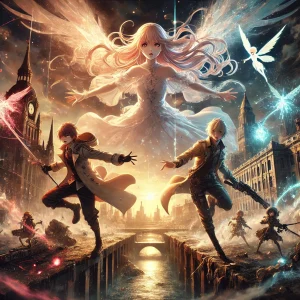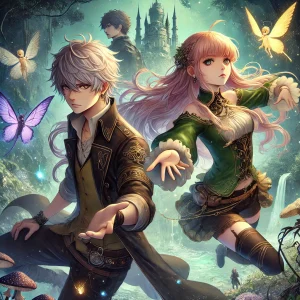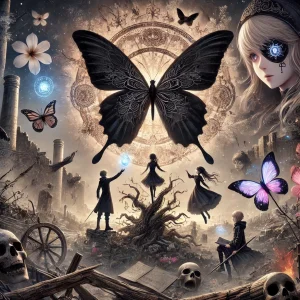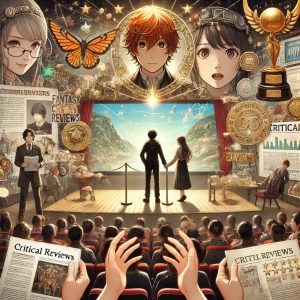Introduction to Fairy gone

So, you're curious about "Fairy gone," huh? Well, let me tell you, it's not just any ordinary anime. Imagine a world where fairies aren't just cute, magical creatures, but powerful entities that can be weaponized. Intrigued? You should be! This anime dives deep into a dark fantasy realm, blending intense action with a richly detailed storyline that's sure to keep you hooked.
At its core, "Fairy gone" is set in a post-war world where fairies are no longer mystical beings of folklore but are embedded within humans to create super-soldiers known as "Fairy Soldiers." The premise revolves around these soldiers who are left trying to find their place in a society that no longer needs them. Sounds gripping, right? It is! The main character, Marlya Noel, teams up with fellow ex-soldier Free Underbar to hunt down illegal fairy users and restore order, while also seeking personal redemption.
What really sets "Fairy gone" apart in the fantasy genre is its unique blend of magic and technology. Unlike other fantasy series that stick to medieval settings, "Fairy gone" introduces a modern twist with elements of noir, creating a world that's both familiar and fantastical. The dark and gritty atmosphere, combined with high-stakes battles and morally complex characters, offers a fresh take on the genre.
But wait, there's more. The series doesn't shy away from exploring deep themes like the consequences of war, the struggle for identity, and the moral ambiguities of power. It's this thoughtful storytelling that elevates "Fairy gone" beyond just another action-packed anime. You'll find yourself pondering the characters' choices and the societal implications long after the episodes end.
And let's not forget the stunning visuals and music. The animation quality is top-notch, with beautifully choreographed fight scenes that keep you on the edge of your seat. The music, composed by [insert composer], perfectly complements the show's tone, enhancing the overall experience and immersing you deeper into the world of "Fairy gone."
Plot Overview

Hey there, ever wondered what makes "Fairy gone" so captivating? Let's dive into the main storyline. Picture this: a world recovering from a devastating war where fairies, those mystical beings from legends, are real and have been weaponized. Sounds wild, right? That's the premise of "Fairy gone."
The story kicks off with Marlya Noel, a young woman with a tragic past. She lost everything during the war and has been on a quest for revenge ever since. Marlya joins Dorothea, an organization tasked with dealing with fairy-related crimes. Here, she meets Free Underbar, an ex-soldier with his own dark history. Their partnership is central to the story, and through their missions, we get a glimpse of the world's complex history and the lingering scars of war.
One of the key events that set the tone is the Black Fairy Tome incident. This ancient text supposedly holds secrets to immense power, and everyone wants a piece of it. Dorothea's mission to retrieve the tome pits them against various factions, each with its own agenda. This conflict introduces us to a range of characters, each more intriguing than the last.
Now, let's talk plot twists. Early on, we discover that not all fairy soldiers are allies. In fact, some of them have turned to crime, using their powers for personal gain. This revelation leads to intense battles and moral dilemmas for our heroes. The stakes get higher when it's revealed that Ver, Marlya's childhood friend who she thought was dead, is alive and entangled in a shadowy conspiracy. Talk about a game-changer!
As the series progresses, the hunt for the Black Fairy Tome and the battles against rogue fairy users escalate. We see Marlya and Free face off against formidable enemies, including powerful fairy soldiers and corrupt officials. Each episode peels back another layer of the world's dark past and the true extent of the corruption within its ranks.
The story unfolds with a perfect blend of action and emotion. We see Marlya grow from a revenge-driven girl to a determined protector, willing to fight for a better future. Free's journey is equally compelling as he grapples with his haunted past while trying to uphold justice. Their evolving dynamic adds depth to the series, making their victories and losses feel incredibly personal.
Throughout the series, the tension builds up to a climactic showdown. The final episodes are a rollercoaster of revelations and confrontations, as the true mastermind behind the chaos is revealed. Marlya and Free must confront their deepest fears and make tough choices to save their world from plunging back into war.
Character Profiles

Let's talk characters! "Fairy gone" boasts an ensemble of intriguing personalities that drive its gripping narrative. Who are these characters, and what makes them tick? Let's dive in.
First up, we have Marlya Noel. Marlya is our main protagonist, a young woman with a tragic past. Orphaned by the war, she joins Dorothea, an organization dedicated to handling fairy-related crimes. Marlya isn't just any member; her fairy ability makes her a force to be reckoned with. Throughout the series, she evolves from a vengeance-seeking girl into a determined fighter for justice. Her quest to find her childhood friend, Veronica, adds layers to her character, showing her loyalty and emotional depth.
Speaking of Veronica, or Veronica Thorn, she's a complex character shrouded in mystery. Once Marlya's best friend, she now walks a dark path, driven by her own brand of justice. Her actions often put her at odds with Marlya, creating a tension-filled dynamic that's central to the plot. Veronica's transformation from an innocent girl to a vengeful vigilante highlights the show's themes of loss and redemption.
Next, we have Free Underbar. Free is a former soldier and a key member of Dorothea. His calm demeanor and strategic mind make him a natural leader. Free's backstory is as rich as it is tragic; haunted by the ghosts of his past battles, he finds solace in his work with Dorothea. His relationship with Marlya is one of mutual respect and trust, evolving from mere colleagues to close allies. Their bond is a cornerstone of the series, providing both emotional depth and strategic partnership.
Wolfran Row is another pivotal character. Once a proud soldier, he now walks a path of vengeance after losing his family in the war. Wolfran's story is a poignant exploration of grief and the lengths one might go to for retribution. His encounters with Free and Marlya add a layer of moral ambiguity to the series, making viewers question the nature of justice and revenge.
Then there's Swee Pea, a member of Dorothea and a close friend of Free. Swee's light-hearted nature and unwavering loyalty bring a sense of camaraderie to the team. Her interactions with Free and Marlya add warmth to the otherwise intense narrative. Swee's development from a supportive side character to a crucial member of the team showcases her growth and adaptability.
Damian Carme, another Dorothea operative, brings his unique skill set to the table. His sharp wit and combat prowess make him a valuable asset. Damian's playful banter with Swee and his strategic insights during missions highlight his multifaceted personality.
Now, let's not forget the antagonists who add spice to the story. Beevee Liscar and his cohort are central to the conflict, challenging our heroes at every turn. Liscar's ruthless pursuit of power and his manipulation of fairy abilities make him a formidable foe. His character serves as a stark contrast to the ideals of Dorothea, setting the stage for epic confrontations.
Throughout "Fairy gone," character development is key. Marlya and Free's evolving relationship, Veronica's descent into darkness, Wolfran's quest for vengeance, and Swee and Damian's growth all contribute to a rich tapestry of human experiences. These characters aren't just part of the story; they are the story, each bringing their own perspectives and motivations to the fore.
Themes and Motifs

Alright, let's dig into what makes "Fairy gone" tick. This anime isn't just about flashy battles and cool fairy powers; it's packed with deep themes and recurring motifs that give it real substance. Let's break it down.
First up, the theme of war is front and center. "Fairy gone" is set in a post-war world where the remnants of conflict are still very much alive. The series doesn't shy away from showing the harsh realities of war and its aftermath. Characters like Marlya and Free are haunted by their pasts, and their stories are a poignant reminder of how war leaves scars, both visible and invisible. This theme is woven throughout the narrative, influencing characters' decisions and the overall tone of the series.
Next, let's talk about magic. In "Fairy gone," magic isn't just a plot device; it's integral to the world's fabric. Fairies, with their unique powers, are embedded within humans, creating "Fairy Soldiers." This blending of human and fairy elements explores the ethical implications of using magical beings as tools of war. The series delves into how this magic affects individuals and society, raising questions about the cost of such power.
And then there's betrayal. This theme is a constant undercurrent, driving much of the drama and tension. Marlya's hunt for her childhood friend Veronica, who has taken a dark path, is a prime example. The betrayal isn't just personal; it's political and societal. Characters must navigate a world where trust is scarce, and alliances can shift in an instant. This sense of betrayal adds layers of complexity to their relationships and motivations.
Now, let's dive into the recurring motifs. One standout is the Black Fairy Tome, a powerful artifact that everyone seems to be after. This tome symbolizes the quest for power and the lengths to which people will go to obtain it. Its presence in the story constantly reminds viewers of the dangers of unchecked ambition and the moral ambiguities of power.
Another important motif is the butterfly. You might have noticed butterflies appearing throughout the series. They often symbolize transformation and the delicate balance between life and death. For characters like Marlya, butterflies represent her personal growth and the fleeting nature of peace. This motif subtly enhances the narrative by adding a layer of visual and thematic depth.
The mask is yet another recurring symbol. Characters often hide their true intentions, donning metaphorical masks to navigate the treacherous political landscape. This motif underscores the theme of deception and the duality of human nature. It’s a constant reminder that appearances can be deceiving, and true motives often lie beneath the surface.
So, how do these themes and motifs enhance the narrative? Well, they add richness and depth, transforming "Fairy gone" from a simple action series into a thought-provoking drama. The exploration of war's impact makes the characters' struggles more relatable and poignant. The ethical questions around magic challenge viewers to think about the consequences of their actions. And the betrayals and deceptions keep the plot unpredictable and engaging.
These elements also help to build a more immersive world. The motifs of the Black Fairy Tome, butterflies, and masks create a cohesive visual and thematic language that ties the story together. They provide continuity and resonance, making the narrative more compelling and memorable.
Reception and Impact

Let's chat about how "Fairy gone" has been received and its impact on the anime community and the fantasy genre. You might be curious about what critics and fans have to say, and trust me, there’s a lot to unpack here.
First off, critical reception has been a mixed bag. Some critics praised "Fairy gone" for its unique premise and intricate world-building. They appreciated how the series blends dark fantasy with elements of political intrigue, creating a complex narrative that's both engaging and thought-provoking. The animation quality, especially during the fairy battles, was another highlight for many reviewers. However, not everyone was on board. Some critics felt that the story's pacing was uneven, with certain episodes dragging while others felt rushed. Despite these critiques, the show's ambition and depth were generally acknowledged.
On the audience response front, "Fairy gone" garnered a dedicated fanbase who admired its bold storytelling and rich character development. Fans were particularly drawn to the moral complexities and the emotional arcs of characters like Marlya and Free. The show's exploration of themes like betrayal, war, and redemption resonated deeply with many viewers. Online forums and social media buzz reflected a strong engagement, with fans eagerly discussing plot twists, character motivations, and the broader implications of the fairy-human dynamic. Of course, there were some who echoed the critics' concerns about pacing and clarity, but the series' unique charm won over many.
When it comes to awards and recognitions, "Fairy gone" may not have swept major awards, but it did receive nods for its animation and music. The series was noted for its distinctive visual style, which brought the world of fairies and humans to life in a vivid and immersive way. The soundtrack, composed by [insert composer], was another standout, perfectly capturing the series' dark and mystical tone. These elements combined to create an atmospheric experience that set "Fairy gone" apart from other anime in the fantasy genre.
So, what about the influence of "Fairy gone" on the fantasy genre and the anime community? Well, its impact is subtle but significant. "Fairy gone" introduced a fresh take on the fantasy genre, blending traditional fairy lore with a gritty, war-torn setting. This unique combination has inspired other creators to experiment with mixing different genres and themes. The series' willingness to tackle complex moral issues and its focus on character-driven storytelling has also set a new standard for narrative depth in fantasy anime.
Moreover, "Fairy gone" has sparked discussions within the anime community about the use of magic and technology, the consequences of war, and the ethical dilemmas faced by its characters. These conversations have enriched the broader dialogue about what fantasy anime can achieve, pushing the boundaries of the genre and encouraging more ambitious storytelling.
In terms of community engagement, "Fairy gone" has fostered a dedicated fanbase that actively participates in fan art, cosplay, and online discussions. This vibrant community keeps the series alive long after its initial airing, highlighting its lasting appeal and influence. The show's blend of dark themes and intricate plot has also attracted viewers who might not typically watch fantasy anime, broadening the genre's audience and appeal.
So, whether you’re a fan of dark fantasy or just looking for a series with rich storytelling and complex characters, "Fairy gone" has made a notable mark. Its reception might be mixed, but its impact on the anime community and the fantasy genre is undeniable. Dive into its world, and you'll see why it continues to captivate and inspire.
